TRY THIS DELICIOUS ALASKA BARLEY-MUSHROOM-COUSCOUS RECIPE
By BRENDA JOSEPHSON
Alaska-grown, harvested, processed, and packed, America’s northernmost commercial flour mill and bakery is contributing to Alaska’s food security with a variety of products created from “the world’s most nutritious hulless barley.”
Flour, grits, couscous, cornbread, risotto, stew mixes, pancakes, brownies, rolls, buns, pizza, and countless other barley products are grown, milled, and prepared by Alaska Flour Company.
Bryce and Jan Wrigley, along with their family, moved to Delta Junction in 1983 with the goal of increasing Alaskans’ access to healthy, sustainably produced food. Since then, they have worked tirelessly to fulfill their vision, and now they are able to offer these locally grown products for your table.
The Wrigley family’s dream was able to come to fruition in part due to the State of Alaska’s Delta Barley Project. The project made available large parcels of land with agricultural rights and loans to fund startup costs. However, in order to achieve sustainability, the farmers had to overcome a variety of challenges, including a barley market collapse, logistical issues, and the high operating costs associated with farming in Interior Alaska.
The establishment of the Delta Barley Project took place in the 1970s, during a period of abundant oil revenue for the State of Alaska. Gov. Jay Hammond promoted the farming project because he understood the importance of building a renewable resource base to support Alaska after oil depletion. The initiative chose small grains and barley as target crops because of their demonstrated capacity to survive in Alaska’s colder temperatures and shorter growing season.
Watch this vintage video from 1982 on the Delta Barley Project:
Delta barley farmers rely on seed from the Alaska Plant Materials Center. Sunshine Hulless barley was developed at the University of Alaska Fairbanks for human consumption. It is a short-season crop that is cold-weather tolerant and is a superfood with a low glycemic index, high in beta-glucan soluble and insoluble fiber, and the most fiber of any grain. UAF conducts ongoing research to improve the barley for Alaska’s farmers in Delta Junction.
Bryce Wrigley sees himself as a temporary steward of the land on his farm in Delta Junction. He promotes healthy soils by practicing regenerative agricultural practices such as no-till farming, cover crop planting, and biodiversity enhancement. The family started practicing no-till methods on the fields in 2010.
Since making the change, he has experienced more consistent crop yields. He said, “I fell in love with the ability of no-till to retain moisture in the field.”
He explained that the crops rely on spring rains to germinate. Prior to switching to no-till, they had inconsistent germination, with green grain mixed in with ripe grain. The uneven growth was caused by insufficient moisture throughout the tilled fields, resulting in some seeds not receiving enough water to germinate. The no-till method provides balanced moisture retention while improving soil health.
The farm’s 1,700 acres are divided into three rotations: 500 acres of barley, 500 acres of hay, and 500 acres fallow, with the remaining 200 acres preserved with trees as windbreaks. The regenerative practices have resulted in improved soil conditions.
“After seven years, I can see that there is a cover crop advantage. In Alaska, there is not enough time to plant during the fall germination period. So, we plant a cover crop the next year when the field is lying fallow. We feed the soil with the cover crop, leave it unharvested, and then plant on top of it the following year. As humus builds and the top layer deepens, the soil becomes darker,” he said.
Bryce views his stewardship of the land as a commitment to not only raise barley responsibly and sustainably but also to “do everything we can to increase sustainability.” He says he’s excited about the gains in soil health that are occurring, but “the more I learn, the more questions I have.”
Learn more about the regenerative agriculture practices Delta Junction farmers are using at these links:
Delta Junction 3rd Annual Soil Health Field Day
The Wrigleys’ vision to help address Alaska’s food security was realized in 2011, when Alaska Flour Company was founded. In addition to helping to meet our region’s nutritional needs, the commercial flour mill is opening up new markets for Delta barley farmers’ grain.
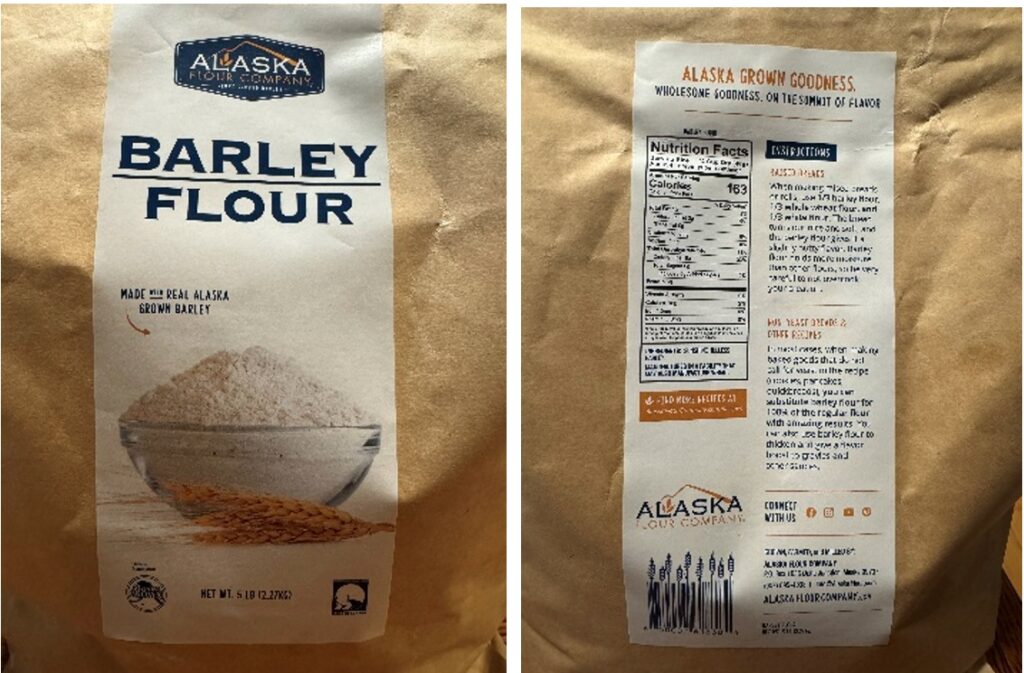
In addition to stone-ground flour, Bryce’s son, Milo Wrigley, has been working hard in the mill to develop a complete barley product line for the retail market, including hot barley breakfast cereal, barley grits, pancake mixes, cornbread, cakes, muffins, barley risotto, couscous, stew mixes, muffins, cakes, brownies, and more.
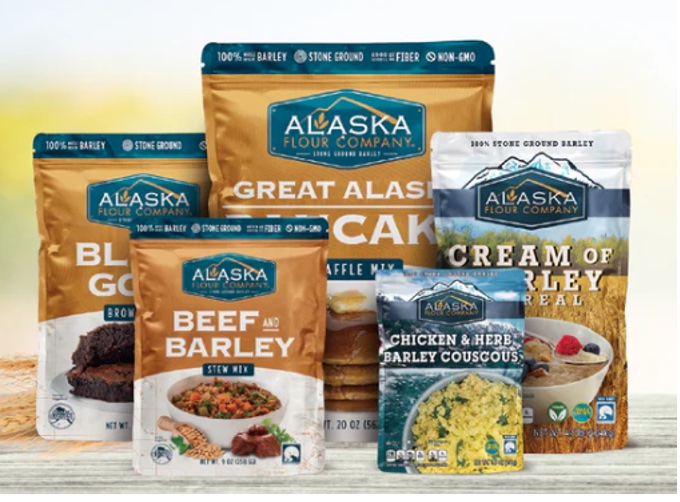
Alaska Flour Company’s products are available at retail locations statewide and can also be purchased online at their website. Be sure to check out their recipes and tips.
In 2023, the company’s product line was expanded to include baked items. The idea arose after talking with restaurateurs who said they were having difficulty getting personnel to completely staff their kitchens. In response to this need, they established a bakery in their Delta Junction facility to supply pre-baked and frozen products directly to restaurants.
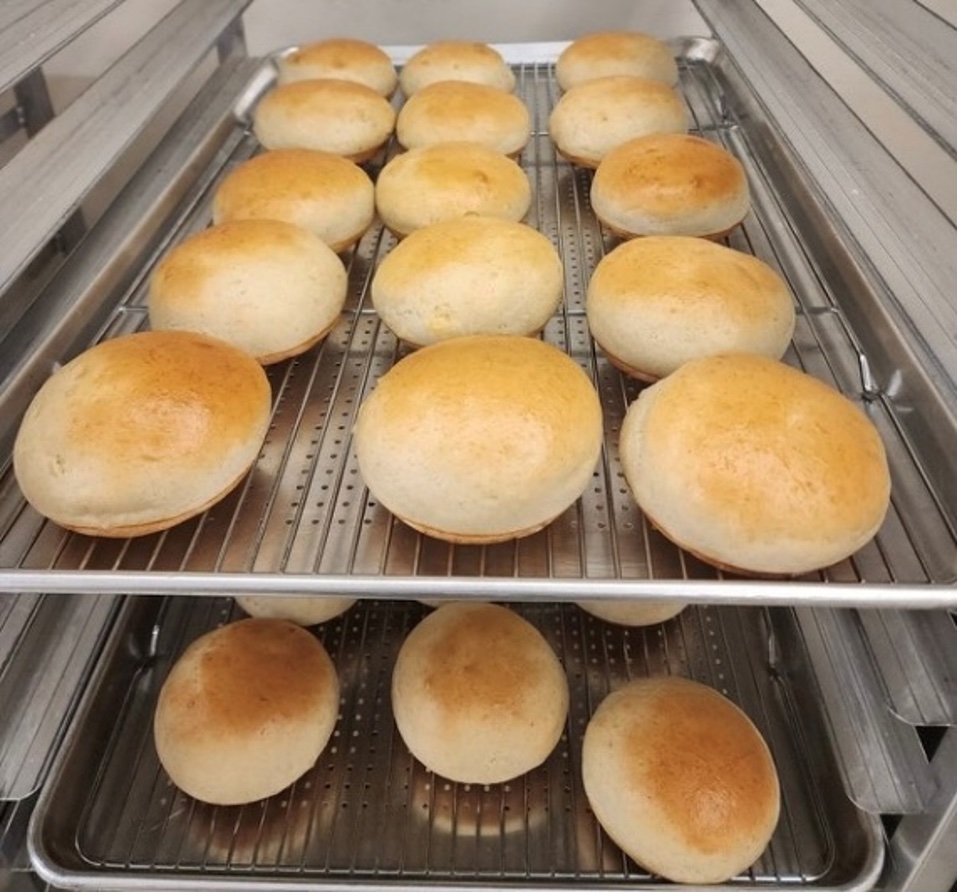
Their product line now includes hamburger buns, dinner rolls, sub rolls, sandwich bagels, brownies, cornbread, cookies, cookie dough, and pizzas for the restaurant industry. The company has a proactive approach and is always willing to work with customers to develop new items to meet their needs.
To achieve food security in Alaska, we need people who are willing to do things differently and take risks. The Alaska Flour Company exemplifies how one family’s desire to provide healthy, sustainably produced food in our region has evolved into a business that offers a complete line of locally grown barley products and baked goods.
Learn more about Alaska Flour Company, at this link Alaska Flour Company Video Link and visit their website at https://alaskaflour.com/ for a list of their barley offerings and the locations of retailers that carry their products.
In-state food producers face unique challenges due to our region’s climate, production costs, and logistics. As we seek to increase our statewide ability to meet our sustenance needs, we can all contribute by supporting producers and retailers who sell Alaskan-grown products. This will help create capacity to deliver more items at lower costs.
Support Alaska’s food security by buying local when possible and checking for Alaska Grown and Alaska Made labels on products in your stores.
Try this scrumptious recipe using Alaska Flour Company’s barley couscous. It is full-flavored and high in nutrients to satiate your hunger and fuel your body.
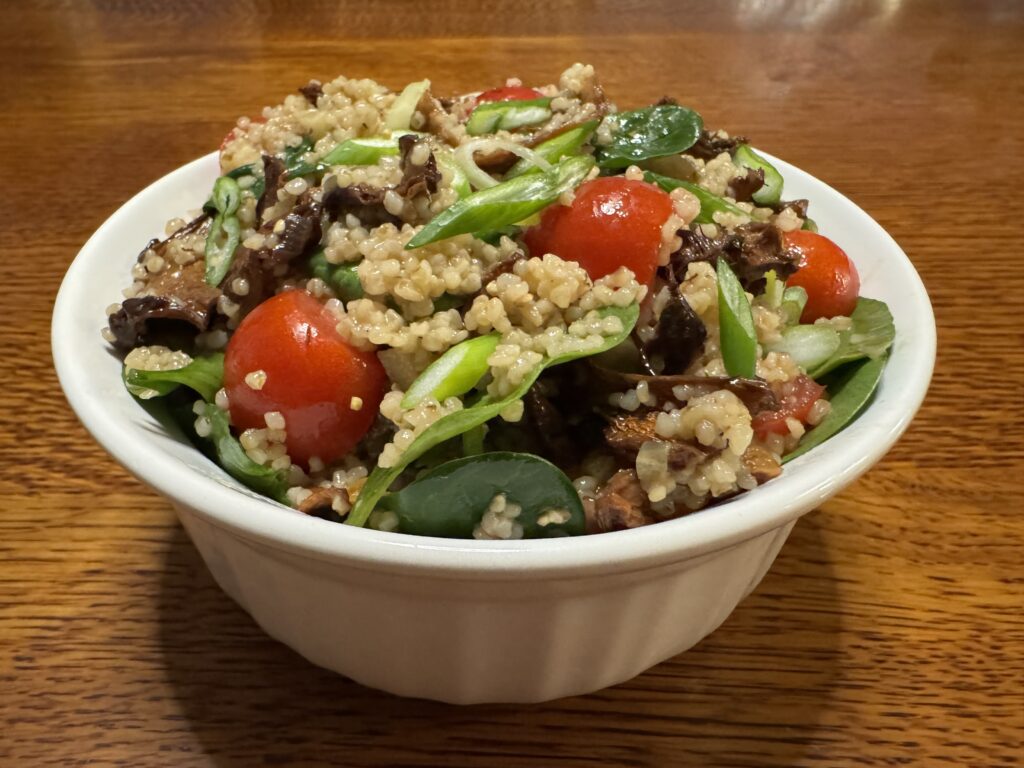
Alaska Barley Couscous and Mushroom Salad
Ingredients:
1 cup of barley couscous
2 1/2 cups of chicken stock (or substitute vegetable stock or bone broth)
4 ounces of mushrooms sliced
2 tablespoons butter
1 shallot (or substitute a small onion) finely diced
1 clove of garlic minced
1 1/2 ounces of red wine (or substitute white wine or chicken stock)
1 cup of cherry tomatoes washed and cut in half
1 cup of spinach (or substitute kale) washed and torn into bite-size pieces
1 lemon juiced
2 tablespoons of olive oil
1/2 teaspoon salt (more or less to taste)
1/2 teaspoon pepper (more or less to taste)
1 to 2 green onions for garnish (optional)
Makes 4 servings
Preparation:
Start by gathering and preparing the cherry tomatoes, spinach, juice of the lemon, and olive oil. Wash and tear the spinach into bite-sized pieces, cut the cherry tomatoes in half, juice the lemon, and have the olive oil available. Place the spinach and cherry tomatoes in a large bowl and set aside until the couscous and mushrooms are ready to add to the salad ingredients.
Place the chicken stock and barley couscous into a small saucepot over high heat and bring to a boil. Once it is boiling, stir and reduce to a simmer. Place a cover on the pot and let simmer for 8 to 10 minutes, stirring occasionally to prevent sticking to the bottom. Then remove it from heat, remove the cover, and stir. Let it sit while you prepare the other ingredients.
While the couscous is simmering, melt the butter in a saute pan over medium-high heat and add the sliced mushrooms. Cook the mushrooms until they start to caramelize. When the mushrooms start to brown, add the wine and stir to deglaze the pan. Continue to cook the mushrooms until the wine evaporates. Then add the diced shallot and 1/4 teaspoon of salt and pepper; cook until the shallots start to become translucent. Reduce the heat to medium and add the garlic. Cook for one to two minutes, stirring constantly to ensure the garlic does not scorch.
Then stir the prepared couscous with a fork to fluff. Add the couscous to the mushrooms, onions, and garlic, stirring to mix together. Allow the couscous to blend with the mushrooms under medium heat for a minute or two, then turn off the heat.
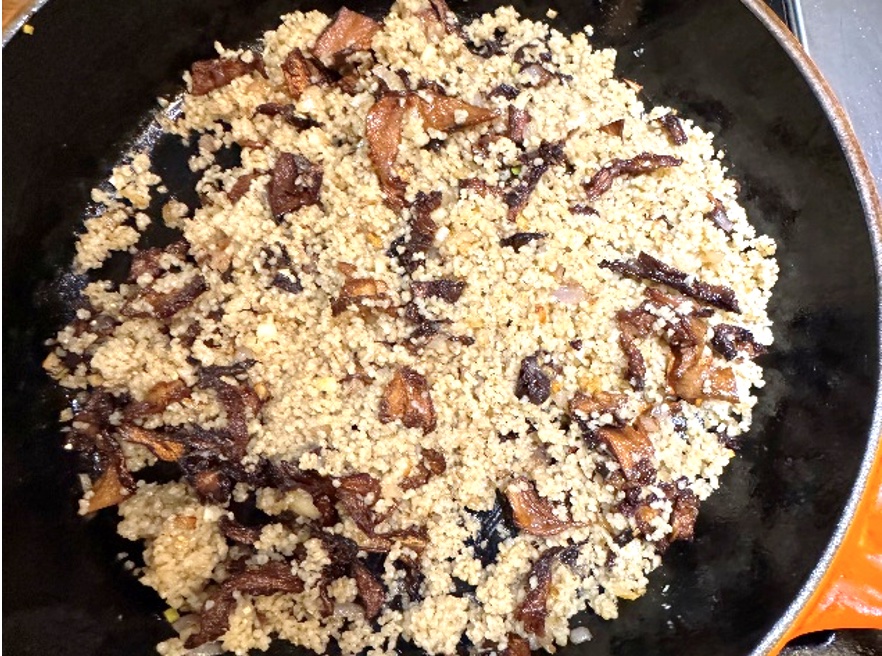
At this point, you have a delicious mushroom couscous dish that can be enjoyed on its own or as a side dish, perfectly complementing a variety of fish and game meals. Or you can elevate the dish by continuing to add the fresh salad ingredients.
To continue to make the barley couscous and mushroom salad, add the warm mushroom couscous mixture to the spinach and cherry tomatoes and mix together. Finally, add the lemon juice and olive oil and mix all ingredients. Taste and add salt and pepper if desired. Garnish with sliced green onions.
Serve immediately for a warm couscous salad. If you prefer a chilled salad, refrigerate it for an hour before serving. This dish holds up well in the refrigerator and is a tasty leftover to enjoy the next day.
Brenda Josephson is a Haines resident. She holds degrees in Culinary Arts and Food Business Leadership from the Culinary Institute of America, Hyde Park, New York. She enjoys spending time fishing, foraging, and savoring Alaska’s abundance of natural and wild foods with her family.
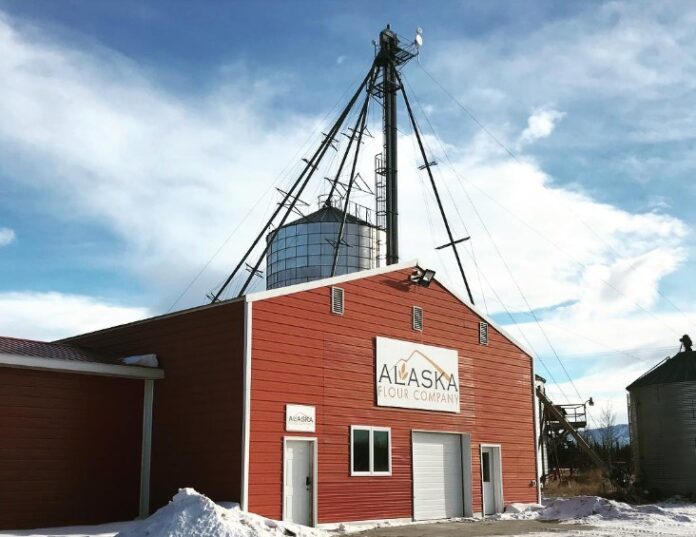
It doesn’t look like what’s for dinner. Unless I was hungry. Then I’d be grateful and appreciative.
Great article, Suzanne!
I love the idea of Alaskan-grown food, and spend at least a week each summer in the Delta Junction area, where I have driven by and seen many of the barley fields there many times. It just saddens me that I cannot partake of any of that locally-grown grain, having celiac disease which makes wheat, rye and barley essentially poisonous to me. Yes, that includes beer.
Dang. No beer? – sd
Nope. What beer is not made from barley is made from wheat.
It’s OK, though. Having suffered with celiac since infancy, I found out seven years ago what my lifelong problem had been, and took dietary steps to correct it, which have been successful. So all the physical misery I had been living with for all those years is now hopefully behind me.
Jeff,
There are gluten free beers out there, I’m not sure how good they are but they are made from various other grains that do not contain gluten like rice. That piss-water so called beer Budweiser is made with a high percentage of rice but they mix in wheat or barley so there is still some gluten.
Welcome back.
Yeah my wife is the same no Gluten for her or life threating.
Thanks for this article!
I absolutely love, love love their Barley flour as one of the flours for dinner rolls and sandwich bread and have been using it for years!
Love Alaska Flour Company! All their products are wonderful and we send the couscous mixes to friends and family outside and they all love it. Most Three Bears carry their products but not all together. You need to go to the aisle that carries a particular category. The barley flour is in the organic section as well as baking. Couscous is with the rice products. Brownie mix with baking, etc.
Bryce and family are fantastic & hardworking, it’s great to see them successful in a very harsh area of our state.
Now how about a few new Dairies. It’s ludicrous to ship milk 1400 miles to our market.
Good point, Doug!
There is one Alaskan dairy, also in the Delta Junction area: Alaska Range Dairy. They sell a whole, ultra-low-temperature-pasteurized, UNhomogenized milk that is the next best thing to raw cow’s milk that I have ever had. I use their milk exclusively! It is sold through Three Bears, the closest one to Anchorage being in North Birchwood.
Walmart in ER carries it too! Their yogurt is fantastic!
I love their products! I take their ” Cream of Barley ” along on hunting trips for breakfast. (On fall hunts add blueberries and canned milk!)
Their Barley Brownie mix is THE BEST BROWNIE ever! Seriously!
100% oat flour makes fantastic brownies, too. Also banana bread.
I have been involved in promoting Alaska Ag for 4 years: both the superb Alaska Range Dairy and Wrigley’s barley operation. What we need is VENTURE CAPITAL to process our potential. In the entire state, only the Wrigley’s have a mill! And the Plagerman’s dairy processes their products. There is 20,000 acres lying fallow in DJ because they need more processors: meat packers, dairies and milling operations. So, the farmers and the land are ready, but they need the ag businesses for Alaskan food security to reach its potential.
I used their chocolate chip cookie mix and it was great…..too good – I ate them all myself the same day i made them!
I eat their Cream of Barley every morning. Mix in blueberries, cinnamon, honey and cayenne pepper. And of course, made with milk. It’s very satisfying and my system loves it. I have never been able to find the large bags in stores, so I order it direct.
Alaska Farmland Trust is a nonprofit devoted to protecting and preserving farm land in Alaska, since it’s PFD filing season remember them when and if you participate in pick.click.give. We need more farm land in Alaska, not less
Sunshine Barley is a fantastic variety. Kudos to UAF for developing it. Unfortunately, I don’t know where to buy seed. We got it directly from UAF a decade ago and continue to re-use open pollinated seeds. UAF is currently working on developing higher yield next-generation varietals. It’s really exciting progress.
Sunshine is easy to de-hull, makes an excellent pilaf, and also makes really good muffins and such from the flour.